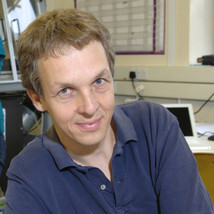Institut
- Homepage
- Aktuelles
- Mitarbeiter A-Z
- Arbeitsgruppen
- Direktorium
- Kolloquium
- Tagungen
- Ausstattung
- Hochtechnologiezentren
- Informationen
- Pressemitteilungen
- Geozentrum
- How to get to IfG
Studium
- Studieninteressierte
- Studienanfänger
- Bachelorstudium
- Masterstudium
- Studienorganisation
- Studienberatung
- Geländeveranstaltungen
- Arbeitsthemen
- Prüfungsamt
Prof. Wolfgang Müller
AG Geology and Palaeoenvironmental Research
Employment
| 1/2015 - 7/2017 | Professor of Isotope Geochemistry, Royal Holloway University of London, UK | |
| 1/2013 – 12/2014 | Reader in Isotope Geochemistry, RHUL, UK | |
| 7/2009 - 12/2012 | Senior Lecturer in Isotope Geochemistry, RHUL, UK | |
| 7/2004 - 6/2009 | Lecturer in Geosciences, RHUL, UK | |
| 11/2003 – 6/2004 | Research Fellow, The Australian National University, Canberra, Australia | |
| 11/2000 – 10/2003 | Postdoctoral researcher, The Australian National University, Canberra | |
| 5/1998 – 10/2000 | Postdoctoral researcher, Swiss Federal Institute of Technology (ETH) Zürich, CH | |
| 4/1994 – 3/1998 | Research / Teaching Assistant at ETH Zürich, Switzerland |
Education, Qualifications and Awards
| 10/2015 | Fellow of The Higher Education Academy, UK | |
| 7/2014 | ‘Excellence in Teaching’ Prize, Royal Holloway University of London (UK | |
| 9/2004 – 9/2006 | CAPITAL: Postgraduate ‘Certificate in Academic Practice in Teaching and Learning’: Accredited two-year programme for newly-appointed academic staff, RHUL, UK (distinction 1/2007) | |
| 7/2000 | Postdoctoral Fellowship for Advanced Researchers, Swiss National Science Foundation (3 years; ANU postdoctoral period) | |
| 5/1994-3/1998 | Ph.D. in Isotope geochemistry & Structural geology/Tectonics, ETH Zürich, Switzerland; Thesis: Isotopic Dating of Deformation Using Microsampling Techniques: The Evolution of the Periadriatic Fault System (Alps). Supervisors: Prof. R.H. Steiger, Prof. N.S. Mancktelow | |
| 10/1994-5/1996 | Postgraduate course in Applied Earth Sciences, Swiss Federal Institute of Technology (ETH) Zürich, Switzerland. Successful completion April 1997 | |
| 3/1994 | Diploma in Natural Sciences (Geology; BSc+MSc equiv.), ‘with distinction’, Universität Wien, Austria; Thesis: Geochronological and structural constraints on the geodynamic evolution of the easternmost Lower Austroalpine units (Eastern Alps), Supervisors: Prof. M. Thöni (Vienna), Prof. F. Neubauer (Graz, Salzburg)” | |
| 4/1992 | Fulbright fellowship for 5-weeks at Univ. Georgia/California (Santa Barbara), USA |
Research Profile
By applying spatially-resolved isotope and elemental analysis to various archives, we reconstruct the palaeoenvironment at the highest time resolution, from daily to seasonal or annual (see Müller & Fietzke, 2016 for an overview article). Owing to the strongly seasonal climate on Earth, one overarching hypothesis is that changes in seasonality may have contributed to both climate transitions or modified ecological behaviour, hence the necessity for sub-annual time resolution.
We are utilizing fast growing (~0.1-10s mm/yr) biomineral archives such as corals, molluscs, large benthic foraminifera or teeth, besides ice cores and speleothems as archives of sub-seasonal environmental change. Applications include diverse areas in palaeoclimate research, both in ‘deep-time’ and at glacial-interglacial time-scales, as well as palaeoecology and anthropology/archaeology. Deep-time palaeoclimate work includes the development and application of large-benthic foraminifera as a viable new tool especially for the Paleogene (Evans et al. 2012, 2013, 2014, 2015, 2016), as well as Miocene corals and giant clams (Griffiths et al. 2013, Warter et al., 2015, 2017). Glacial-interglacial research focuses on speleothems (Luetscher et al., 2015) or utilizes our pioneering cryo-cell UV-LA-ICPMS methodology to analyze dust in frozen ice at unprecedented spatial/time resolution (~200 μm) to establish the speed of natural abrupt climate change in deep Greenland ice (Müller et al., 2011; Della Lunga et al., 2014, 2017). Work using teeth focuses on various projects including human and faunal samples (e.g. mammoth) ranging from the Pleistocene to modern. Using a combination of spatially-resolved isotope proxies (Sr, O, Ca) in combination with trace element ratios and enamel histology we can reconstruct past life histories at unprecedented resolution (Alt et al., 2013, 2014; Müller & Anczkiewicz, 2016; Li et al., 2016; Müller et al. forthcoming).
A common feature of our research over the years has been the close interplay between applications and the methodological developments necessary to achieve these goals. Good examples illustrating this interplay include 1) Our early work on dating deformation, where we constrained for the first time directly duration and rates of shear zone activity (Science 2000; Terra Nova 2016), 2) the development of in-situ Hf isotope analysis including non-radiogenic ratios applied to the oldest minerals formed on Earth, the Jack Hills zircons (Science 2005), 3) the development of the prototype RESOlution laser-ablation system with two-volume LA cell at Royal Holloway Univ. London in 2006-07 (JAAS 2009), 4) the development of the cryo-cell LA holder for elemental analysis of frozen ice cores at ~200 μm spatial resolution (JAAS 2011; The Cryosphere 2017) or recently 5) triple-quad ICP-QQQ coupled to LA for low-level sulphur in ice cores (2015 NERC grant). Overall, laser-ablation ICPMS (LA-ICPMS) and/or SIMS besides conventional microsampling/ drilling form the cornerstone of our versatile toolkit. In recognition of our LA work we were invited to host an international conference on Laser-Ablation, namely the 2014 European Workshop on Laser Ablation (EWLA2014) with ~170 participants (then at RHUL).
Finally, following on from my PhD research (Müller et al. 2000, 2001, 2002), applications in tectonics include dating brittle deformation using U-Pb applied to calcite slickenfibres (Rittner 2013), laser-cut Rb-Sr microsampling (Egli et al., 2016) and U-Pb dating and Hf-isotope systematics of (detrital) zircons (Lambert-Smith et al., 2016; Harrison et al., 2005; Müller et al., forthcoming). Most recently, using the new triple-quad ICP-QQQ we are exploring direct in-situ Rb/Sr dating of micas.
All this research is highly collaborative and benefits enormously from many existing international collaborations and we very much welcome new collaborations using the excellent facilities here in Frankfurt.




